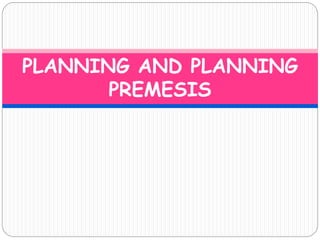
Planning and planning premesis
- 1. PLANNING AND PLANNING PREMESIS
- 2. WHAT IS PLANNING? According to Knootz, Planning is the intellectual process that requires conscious determination of course of action and taking decision on the basis of purpose, knowledge and considered estimates.
- 3. FEATURES/PURPOSE OF PLANNING Prioritizing Determining task and resource Scheduling time for completion
- 4. ESSENTIALS OF PLANNING SYSTEM (GIVEN BY MURPHY) • Clearly defined objective • Clearly identified assumptions • Rational appropriate and comprehensive • Simple • Flexible
- 5. Time bound Balanced Regular analysis and review Utilize available resources and opportunities and new resources Proper coordination between short term and long term plans Free from psychological and social basis of planners Adequate review and controlling mechanism
- 6. CATEGORIES OF PLANNING Strategic and Functional Planning :- Apply to the entire organization, Establish the organization’s overall goals, Seek to position the organization in terms of its environment, Cover extended periods of time Functional planning is undertaken by various department in to the organization to determine their respective , derived from the long term goals and objectives. Formal and Informal planning:- Informal planning takes place when a manager plans institutively without any structure or rigid framework. Formal planning involves a structured process of investigation and action.
- 7. Ad hoc and Standing Planning :- Standing plans are often policies, procedures and programs developed to ensure the internal operations of a given business are operating smoothly. Examples of standing plans include policies for employee interaction, procedures for reporting internal issues in the company and regulations in terms of what is allowable and what is prohibited in the business. Ad hoc plans are basically temporary plan which are made in an organisation to enhance the process of achievement of objective.
- 8. Administration and operational planning :- Operational planning the details of how the overall goals are to be achieved. Cover short time period. Administration planning deals with the making of policies to achieve a particular goal or objective. Long term and short term planning :- It is the process of establishing long-term goals, making our strategies, policies and programmes to achieve these goals. It ranges from 5 years to 20 years or even more. Short terms planning relates to a period of up to one year. Such plans are made to achieve short term goals.
- 9. PROCESS OF PLANNING Determination of objectives Development of Planning Premises Determination of alternative courses of action Evaluation of alternatives
- 10. Formulation of derivative plans Planning of timing and operational Schedule Securing people’s participation Reviewing and controlling plan Budgeting
- 11. PLANNING PREMISIS Planning premises are defined as the anticipated environment in which plans are expected to operate. They include assumptions or forecasts of the future and known conditions that will effect the operation of plans.
- 13. Internal Premises come from the business itself. It includes skills of the workers, capital investment policies, philosophy of management, sales forecasts, etc. External Premises come from the external environment. That is, economic, social, political, cultural and technological environment. External premises cannot be controlled by the business.
- 14. Controllable Premises are those which are fully controlled by the management. They include factors like materials, machines and money. Semi-controllable Premises are partly controllable. They include marketing strategy. Uncontrollable Premises are those over which the management has absolutely no control. They include weather conditions, consumers' behaviour, government policy, natural calamities, wars, etc.
- 15. Tangible Premises can be measured in quantitative terms. They include units of production and sale, money, time, hours of work, etc. Intangible Premises cannot be measured in quantitative terms. They include goodwill of the business, employee's morale, employee's attitude and public relations.
- 16. Constant Premises do not change. They remain the same, even if there is a change in the course of action. They include men, money and machines. Variable Premises are subject to change. They change according to the course of action. They include union-management relations.
- 17. BARRIERS TO PLANNING LACK OF ACCURACY: In planning we are always thinking in advance and planning is concerned with future only and future is always uncertain. In planning many assumptions are made to decide about future course of action. But these assumption are not 100% accurate and if these assumption do not hold true in present situation or in future condition then whole planning will fail.
- 18. PSYCHOLOGICAL BARRIERS: Generally the human beings have a felling of uncertainty related to future. People have preference for the present as compared to the future. The employees fell making assumptions and then changing them according to present conditions involve lots of time and cost. So, it is always advisable to take decision according to present condition only. HUMAN ELEMENT:-The manger who are performing planning function are human beings may make mistakes by making wrong assumption or by selecting the wrong alternative to achieve the objective of organization. The managers involved in planning work may also mislead or misguide the employees by giving priority to personal objective rather than organizational objective.
- 19. CONCLUSION The above points show that planning is not a substitute for success of a organization because it suffers from many limitations. But is does not mean that managers should not perform planning function, rather they should perform planning keeping in mind the limitations of planning and then try to overcome these limitations.
